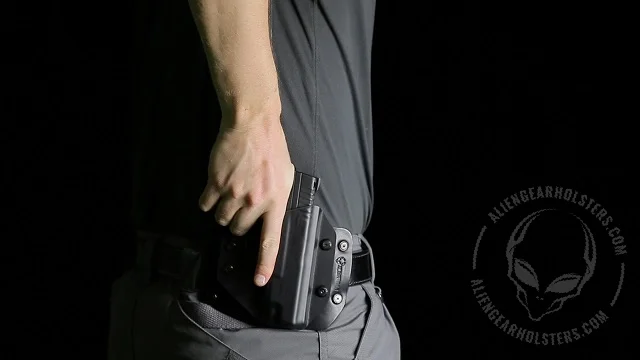
Positives and Negatives of Cross Draw Holsters
Cross draw has hit some heavy criticism in online gun forums. Competition shooters have largely shewed the idea altogether because it adds milliseconds to their time. Serious minded gun owners may have followed suit – but for a different reason.
But, in all honesty, it comes down to how you best feel comfortable carrying concealed. If drawing strong-side isn't a feasible option (which it isn't for some) then maybe it's time we re-examine the concept of cross draw.
In this article, we'll look at a few basic situations where cross draw may apply and then discuss some Pros and Cons for both inside the waistband concealed carry and outside the waistband carry.
Driving While Carrying Concealed

When in the car, if you can feasibly carry, you should. The reason is simple: fumbling in a center console or glovebox or beneath a seat versus drawing straight from the hip can be dangerous.
IWB- : Cross draw IWB has become a favored method amongst taxi drivers because it allows them to carry concealed – a necessity in their line of work – and to easily reach across and grab their handgun.
- PRO: For righties, it's sometimes easier to reach across the body while seated than it is to reach strong-side. For lefties, this logic may not apply.
- CON: Where this logic may be flawed is if a “bad guy” customer reaches up and grabs their seat belt, pulling them in tight against their seat.
Driving While Open Carrying

- : An
- doesn't cramp up in a tight midsection as much as an IWB holster might. Some gun owners report that this is a comfortable and accessible way to carry while driving. If you don't have the dexterity or maneuverability to carry strong-side OWB, you might be able to get away with OWB cross draw.
- PRO: Borrowing from the IWB PRO point, reaching across to access a handgun across the body may be easier – especially if the driver's seating area is cramped or right up on the center console. OWB carry beneath a jacket can arguably be considered concealed in some jurisdictions. As such, you're not fighting to get beneath a jacket AND another layer.
- CON: Unlike in an IWB situation where a “bad guy” could grab your safety belt from the backseat and use it to pin your body – essentially making your waistline difficult to access – open carry OWB doesn't have that problem. However, in that situation, the bad guy would have likely saw that you were armed. If he didn't, good on you.
Walking And Cross Draw – IWB & OWB
Some folks prefer the draw from across the waist versus straight down to the hip. Sure, there's a minuscule difference in timing, but keep in mind that most folks who cross draw are carrying at the 10 o'clock position (2 o'clock for lefties). The time to draw at this position is relatively comparable to appendix carry anyhow.
- PRO: The biggest pro for cross draw from a standing/walking position is the natural sway of the arms forward and back. If you swing your arms across your body naturally, drawing from that would work.
- CON: If you don't naturally sway or swing your arms while walking, it doesn't help.
Ultimately, the people who prefer cross draw have discovered that this particular method works well for them. If you have not extensively practiced your cross draw, it doesn't make sense to carry in that position on an everyday basis – OWB or IWB.
 |
About The Author James England (@sir_jim_england) is the contributing editor for Alien Gear Holsters. He is a veteran of Operation Iraqi Freedom and private defense contracting in Afghanistan. |








